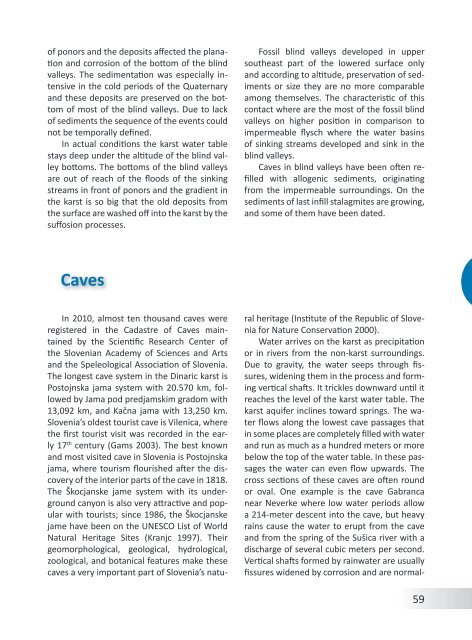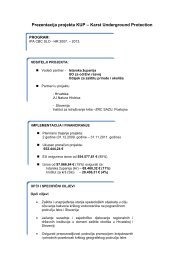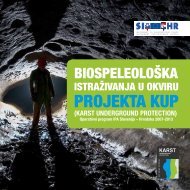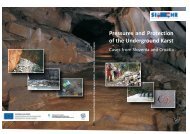Case Studies from the Dinaric Karst of Slovenia
Case Studies from the Dinaric Karst of Slovenia
Case Studies from the Dinaric Karst of Slovenia
You also want an ePaper? Increase the reach of your titles
YUMPU automatically turns print PDFs into web optimized ePapers that Google loves.
<strong>of</strong> ponors and <strong>the</strong> deposits affected <strong>the</strong> planationand corrosion <strong>of</strong> <strong>the</strong> bottom <strong>of</strong> <strong>the</strong> blindvalleys. The sedimentation was especially intensivein <strong>the</strong> cold periods <strong>of</strong> <strong>the</strong> Quaternaryand <strong>the</strong>se deposits are preserved on <strong>the</strong> bottom<strong>of</strong> most <strong>of</strong> <strong>the</strong> blind valleys. Due to lack<strong>of</strong> sediments <strong>the</strong> sequence <strong>of</strong> <strong>the</strong> events couldnot be temporally defined.In actual conditions <strong>the</strong> karst water tablestays deep under <strong>the</strong> altitude <strong>of</strong> <strong>the</strong> blind valleybottoms. The bottoms <strong>of</strong> <strong>the</strong> blind valleysare out <strong>of</strong> reach <strong>of</strong> <strong>the</strong> floods <strong>of</strong> <strong>the</strong> sinkingstreams in front <strong>of</strong> ponors and <strong>the</strong> gradient in<strong>the</strong> karst is so big that <strong>the</strong> old deposits <strong>from</strong><strong>the</strong> surface are washed <strong>of</strong>f into <strong>the</strong> karst by <strong>the</strong>suffosion processes.Fossil blind valleys developed in uppersou<strong>the</strong>ast part <strong>of</strong> <strong>the</strong> lowered surface onlyand according to altitude, preservation <strong>of</strong> sedimentsor size <strong>the</strong>y are no more comparableamong <strong>the</strong>mselves. The characteristic <strong>of</strong> thiscontact where are <strong>the</strong> most <strong>of</strong> <strong>the</strong> fossil blindvalleys on higher position in comparison toimpermeable flysch where <strong>the</strong> water basins<strong>of</strong> sinking streams developed and sink in <strong>the</strong>blind valleys.Caves in blind valleys have been <strong>of</strong>ten refilledwith allogenic sediments, originating<strong>from</strong> <strong>the</strong> impermeable surroundings. On <strong>the</strong>sediments <strong>of</strong> last infill stalagmites are growing,and some <strong>of</strong> <strong>the</strong>m have been dated.CavesIn 2010, almost ten thousand caves wereregistered in <strong>the</strong> Cadastre <strong>of</strong> Caves maintainedby <strong>the</strong> Scientific Research Center <strong>of</strong><strong>the</strong> <strong>Slovenia</strong>n Academy <strong>of</strong> Sciences and Artsand <strong>the</strong> Speleological Association <strong>of</strong> <strong>Slovenia</strong>.The longest cave system in <strong>the</strong> <strong>Dinaric</strong> karst isPostojnska jama system with 20.570 km, followedby Jama pod predjamskim gradom with13,092 km, and Kačna jama with 13,250 km.<strong>Slovenia</strong>’s oldest tourist cave is Vilenica, where<strong>the</strong> first tourist visit was recorded in <strong>the</strong> early17 th century (Gams 2003). The best knownand most visited cave in <strong>Slovenia</strong> is Postojnskajama, where tourism flourished after <strong>the</strong> discovery<strong>of</strong> <strong>the</strong> interior parts <strong>of</strong> <strong>the</strong> cave in 1818.The Škocjanske jame system with its undergroundcanyon is also very attractive and popularwith tourists; since 1986, <strong>the</strong> Škocjanskejame have been on <strong>the</strong> UNESCO List <strong>of</strong> WorldNatural Heritage Sites (Kranjc 1997). Theirgeomorphological, geological, hydrological,zoological, and botanical features make <strong>the</strong>secaves a very important part <strong>of</strong> <strong>Slovenia</strong>’s naturalheritage (Institute <strong>of</strong> <strong>the</strong> Republic <strong>of</strong> <strong>Slovenia</strong>for Nature Conservation 2000).Water arrives on <strong>the</strong> karst as precipitationor in rivers <strong>from</strong> <strong>the</strong> non-karst surroundings.Due to gravity, <strong>the</strong> water seeps through fissures,widening <strong>the</strong>m in <strong>the</strong> process and formingvertical shafts. It trickles downward until itreaches <strong>the</strong> level <strong>of</strong> <strong>the</strong> karst water table. Thekarst aquifer inclines toward springs. The waterflows along <strong>the</strong> lowest cave passages thatin some places are completely filled with waterand run as much as a hundred meters or morebelow <strong>the</strong> top <strong>of</strong> <strong>the</strong> water table. In <strong>the</strong>se passages<strong>the</strong> water can even flow upwards. Thecross sections <strong>of</strong> <strong>the</strong>se caves are <strong>of</strong>ten roundor oval. One example is <strong>the</strong> cave Gabrancanear Neverke where low water periods allowa 214-meter descent into <strong>the</strong> cave, but heavyrains cause <strong>the</strong> water to erupt <strong>from</strong> <strong>the</strong> caveand <strong>from</strong> <strong>the</strong> spring <strong>of</strong> <strong>the</strong> Sušica river with adischarge <strong>of</strong> several cubic meters per second.Vertical shafts formed by rainwater are usuallyfissures widened by corrosion and are normal-59










